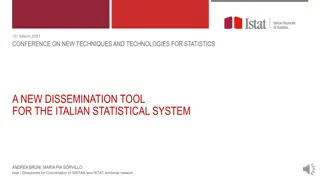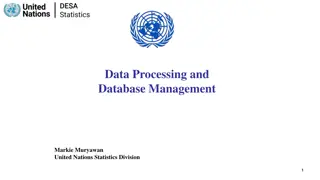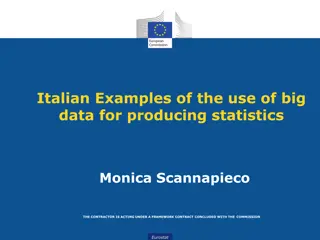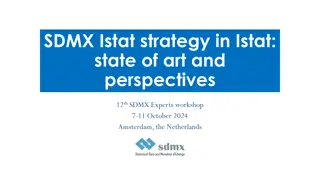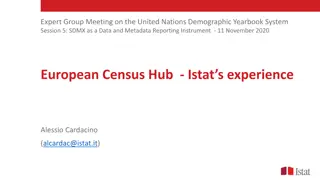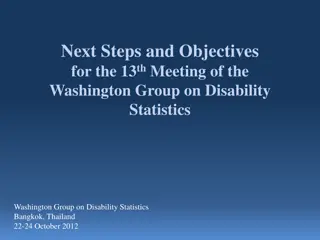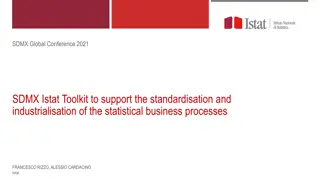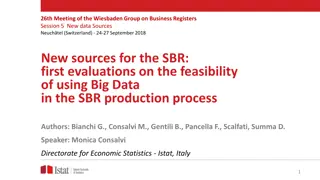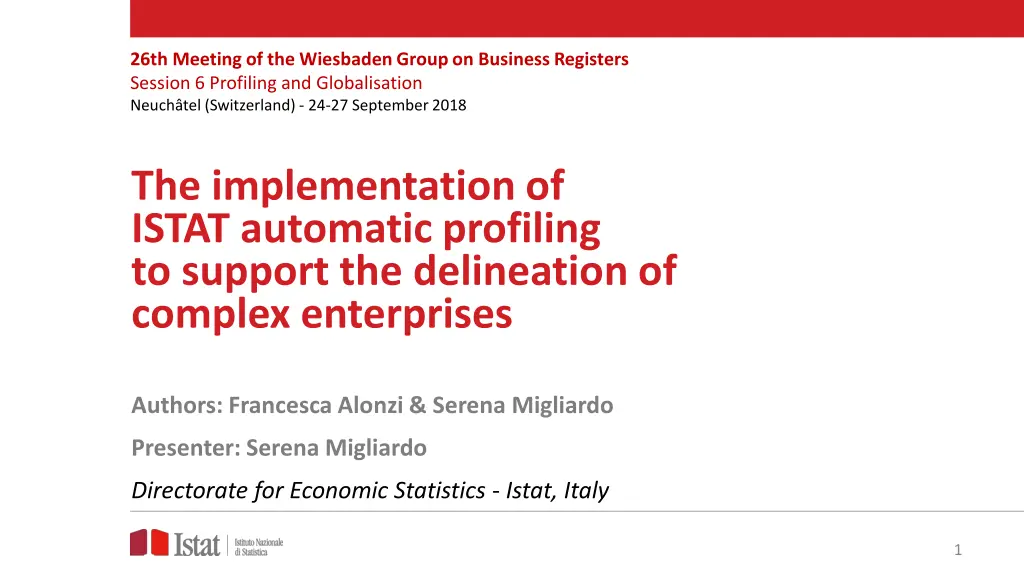
ISTAT Automatic Profiling for Complex Enterprises at Wiesbaden Group Meeting
Explore the implementation of ISTAT automatic profiling to delineate complex enterprises at the 26th Meeting of the Wiesbaden Group on Business Registers. Learn about the legal, economic, and statistical frameworks, as well as the strategy behind automatic profiling and the identification of representative units within business groups.
Download Presentation

Please find below an Image/Link to download the presentation.
The content on the website is provided AS IS for your information and personal use only. It may not be sold, licensed, or shared on other websites without obtaining consent from the author. If you encounter any issues during the download, it is possible that the publisher has removed the file from their server.
You are allowed to download the files provided on this website for personal or commercial use, subject to the condition that they are used lawfully. All files are the property of their respective owners.
The content on the website is provided AS IS for your information and personal use only. It may not be sold, licensed, or shared on other websites without obtaining consent from the author.
E N D
Presentation Transcript
26th Meeting of the Wiesbaden Group on Business Registers Session 6 Profiling and Globalisation Neuch tel (Switzerland) - 24-27 September 2018 The implementation of ISTAT automatic profiling to support the delineation of complex enterprises Authors: Francesca Alonzi & Serena Migliardo Presenter: Serena Migliardo Directorate for Economic Statistics - Istat, Italy 1
Contents Introduction 1. Legal, economic and statistical framework of complex enterprises 2. Automatic profiling: strategy, groups structure, simple groups and complex groups 3. Italian BR groups structures and impact of automatic profiling 4. The representative unit 5. Conclusions and future developments 6. 2 The implementation of ISTAT automatic profiling to support the delineation of complex enterprises Neuch tel (Switzerland) - 24-27 September 2018
Introduction Globalization calls for comparable statistics in Europe and around the world, thus necessarily implying a combination between the pure economic view of business groups and the statistical treatment of enterprises groups. Manual and automatic profiling techniques go in this direction. Objective of the contribution: to describe the methodology, developed by ISTAT, to automatically delineate the new statistical units (ENTs) by exploiting economic theories on groups structures; to offer a first contribution on the identification of a representative legal unit among the set of legal units combined together to form the ENT, able to donate principal attributes to the ENT. 3 The implementation of ISTAT automatic profiling to support the delineation of complex enterprises Neuch tel (Switzerland) - 24-27 September 2018
Legal, economic and statistical framework of complex enterprises The contribution offers an overview on the legal, economic and statistical framework on complex enterprises with the aim of providing the reader with a reference background on the phenomenon. The literature and the economic management theory have identified various types of business groups even if vigorous academic discourse about this organizational form is ongoing (Khanna and Palepu, 2000); for example, as noted by Yiu et al. (2005), recent studies have traced the evolution of business groups in regard to pattern of diversification and organizational structure over time (Kim et al., 2004; Kock and Guill n, 2001). In effect, both economic and juridical studies have identified the key elements of the group as an organizational structure: the presence of a plurality of legal entities and the control of such entities by a sole entity (Di Carlo, 2009). 4 The implementation of ISTAT automatic profiling to support the delineation of complex enterprises Neuch tel (Switzerland) - 24-27 September 2018
Automatic profiling - strategy Automatic profiling developed by ISTAT to delineate the Enterprise by linking together not autonomous resident legal units belonging to the same group, exploits the organizational structures of organizations in line with a theme first explored by Chandler (1962), the existence of an intimate relationship between the strategy of the firm and its organizational structure. Two steps: analysing group s structures in terms of legal units and organization control level; measuring a set of economic aggregates to identifying the new potential ENTs. The methodology requires: an integrated base of micro-data which link together different national data sources; ad hoc correspondence matrices to link potential ancillary and integrated units. being focused on the target population of SBS legal units belonging to SBS Groups. 5 The implementation of ISTAT automatic profiling to support the delineation of complex enterprises Neuch tel (Switzerland) - 24-27 September 2018
Automatic profiling - groups structure More than 80% of Italian SBS groups have an elementary structure with a maximum of 3 resident active legal units in SBS target population; the population of enterprise groups is divided into two segments: simple groups - if the total number of SBS legal units is 3; complex groups - if the total number of SBS legal units is > 3. The basic assumption of this choice lies on the fact that the internal structure of groups in terms of relationships and control level is not relevant for simple groups, while it may be significant in the case of complex groups. For complex groups, for which no intensive or desk profiling activity is planned due to internal/organizational constraints, automatic profiling has to be undertaken. 6 The implementation of ISTAT automatic profiling to support the delineation of complex enterprises Neuch tel (Switzerland) - 24-27 September 2018
Automatic profiling - groups structure Example of a group with a predominantly vertical structure Depending on the structure of the groups of enterprises to be profiled, automatic algorithms slightly differ in the treatment and delineation of the statistical units. The groups morphology, in an economic perspective, is the base for the statistical interpretation of the phenomenon: groups with a mainly vertical structure ; groups with a predominantly horizontal structure ; Example of a group with a pure horizontal structure groups with a matrix structure, articulated both horizontally and vertically. 7 The implementation of ISTAT automatic profiling to support the delineation of complex enterprises Neuch tel (Switzerland) - 24-27 September 2018
Automatic profiling - simple groups Identification of mono-activity groups 1 Group = 1 SBS ENT NACE 4-digit level Value added (VA), Turnover and Persons employed, all being considered at group level. A group is considered as a mono-activity group (1 Group = 1 SBS ENT) if at least 90% of the value of the chosen economic variable (in order VA, Turnover, Persons employed) is concentrated in only one economic activity at NACE four-digit level. If the threshold is lower than 90%, ancillary or vertical integrated activities have to be considered. If the sum of the principal activity, the ancillary or/and the integrated activity is >=90%, the groups can be considered as being mono-activity groups. Simple groups which are not solved as mono-activity groups are considered as multi-activity groups (1 Group = more than 1 SBS ENT). 8 The implementation of ISTAT automatic profiling to support the delineation of complex enterprises Neuch tel (Switzerland) - 24-27 September 2018
Automatic profiling - complex groups In case of mono-activity complex groups, the complex enterprise (ENT) will be easily created (1 Group = 1 ENT), otherwise the indicator on the groups structure has to be considered. Mono- activity groups Groups with vertical and horizontal structures are treated as simple groups and considered as multi-activity groups (1 Group = more than 1 SBS ENT); for groups with a matrix structure there is the need to automatically identify the existence of vertical or horizontal sub-groups able of representing autonomous enterprises. Groups structures indicators Groups has to be broken in sub-groups, by an iterative algorithm; starting from the second level of the group s structures, such algorithm turns and breaks the structures up to bring them back to horizontal or vertical structures. Finally, the condition of mono-activity groups is re-applied on the new sub-structures. Iterative algorithm 9 The implementation of ISTAT automatic profiling to support the delineation of complex enterprises Neuch tel (Switzerland) - 24-27 September 2018
Italian BR groups structures and impact of automatic profiling Italian BR Groups structures RY 2016 As Is To be Impact (var %) Sector of activity Number of LeUs Employm. of LeUs Number of ENTs Employm. of ENTs Impact on LeUs Impact on employm. 6.8 (a) (c) (b) (d) (b-a)/a*100 (d-c)/c*100 37.5 Industry 76,716 1,935,738 56,056 1,955,402 -26.9 1.0 Wholesale 43,091 901,796 32,299 917,939 -25.0 1.8 Services 125,107 1,748,392 73,395 1,715,144 -41.3 -1.9 55.7 Horizontal Holdings 11,631 4,175 2,289 1,617 -80.3 -61.3 Vertical Matrix Total 256,545 4,590,102 164,039 4,590,102 -36.1 0.0 10 The implementation of ISTAT automatic profiling to support the delineation of complex enterprises Neuch tel (Switzerland) - 24-27 September 2018
The representative unit The algorithm of automatic profiling individuates the representative unit as the legal unit carrying out the principal economic activity measured in terms of economic variables used for the delineation of the ENT, being in order: value added, turnover and number of persons employed. Additional indicators 1. Status of activity If only one of the legal units is active, it is considered to be the representative. 2. Legal form When the legal units have different legal forms, it is preferred the legal unit which is a limited company. 3. Level If the legal units occupy different levels in the group structure, the representative unit may be the one with the highest level. 4. NACE code at 5 digits In general, in the classification ATECO 2007, the national version of NACE Rev. 2, the higher is the category (5thdigit) the less important (secondary) is the economic activity. 11 The implementation of ISTAT automatic profiling to support the delineation of complex enterprises Neuch tel (Switzerland) - 24-27 September 2018
Conclusions and future developments Manual profiling activity is more than ever occupying a core position in ISTAT. Next year goal is to manually profile more than 80 groups and collect intra-flows data through an ad hoc SBS survey. However, Italy is characterized by the presence of a large number of complex enterprises, that can not all be delineated with only manual profiling approaches. Automatic profiling is a good method too, if all the necessary information on the organizational structure of the groups are available from the system of Business Registers (BR). The implementation of the new ENT definition imply a full revision of the BR updating process in terms of new procedures, new software, new tables and new variables. It also involves the need to define a new process for assigning the enterprise identification code and to maintain it (new continuity rules). 12 The implementation of ISTAT automatic profiling to support the delineation of complex enterprises Neuch tel (Switzerland) - 24-27 September 2018
Thank you for the attention Serena Migliardo (migliard@istat.it) Francesca Alonzi (alonzi@istat.it) Directorate for Economic Statistics - Istat, Italy 13 The implementation of ISTAT automatic profiling to support the delineation of complex enterprises Neuch tel (Switzerland) - 24-27 September 2018

